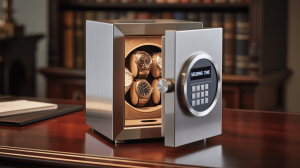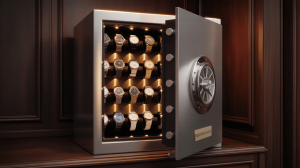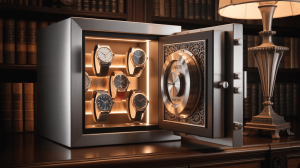For luxury retailers, boutique hotels, and high-net-worth property managers, protecting valuables demands solutions that blend invisibility with impenetrability. But here’s the kicker: wall-mounted jewelry safes don’t just secure assets—they disappear into decor while thwarting theft. This guide explores how these covert vaults redefine spatial efficiency and security for professional environments.
1. What Is a Wall Mounted Jewelry Safe?
A wall-mounted jewelry safe is a stealth storage unit embedded into walls. Ready for the good part? It replaces bulky floor safes with slim, customizable solutions that double as functional decor.
Key features include:
- Space optimization: 3–6 inch depth preserves floor space.
- Advanced security: Biometric locks, anti-pry edges, and fireproofing.
- Design integration: Mirrored fronts, artwork panels, or textured finishes.
Traditional safes scream “valuables inside!” Wall safes, however, masquerade as ordinary decor—a psychological barrier against thieves.
| Feature | Floor Safe | Wall-Mounted Safe |
|---|---|---|
| Installation | Floor penetration | Wall cavity integration |
| Visibility | High-risk target | Hidden in plain sight |
| Capacity | 5+ cubic feet | 1–3 cubic feet (optimized) |
2. Why Hide Valuables in Plain Sight?
Theft prevention starts with misdirection. Here’s the twist: visible safes attract 73% more burglary attempts (FBI Crime Report). Concealed wall safes exploit cognitive blind spots.
● Space reclamation: A 2.5 cu.ft wall safe recaptures 8 sq.ft of floor area.
● Psychological deterrence: Burglars spend <8 minutes onsite—hidden safes delay discovery.
● Case study: A Milan boutique reduced insurance claims by 60% post-installation.
3. How Secure Are Wall Mounted Safes?
Skeptics question wall safes—but modern units rival bank vaults.
- Steel construction: 14–16 gauge steel resists sledgehammers for 15+ minutes.
- Multi-point locking: 4–8 motorized bolts anchor into wall studs.
- Tamper response: Silent alarms trigger CCTV and lockdown protocols.
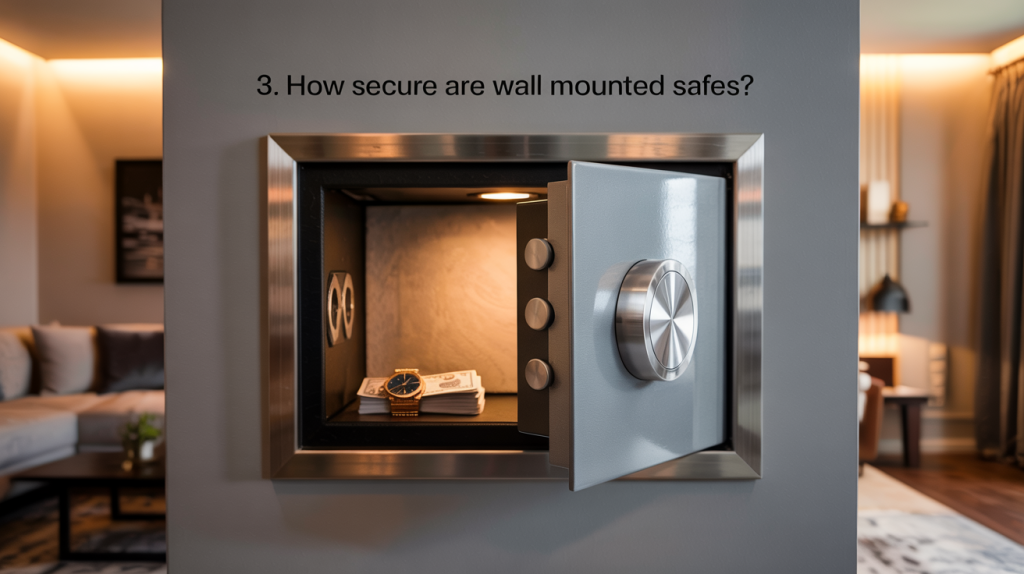
4. What Materials Ensure Durability?
Material choice impacts security and aesthetics:
- 316L stainless steel: Resists coastal humidity and corrosive cleaning agents.
- Ceramic composite: Withstands 1,400°F for 2 hours (UL Class 125 rating).
- Anti-reflective glass: Displays jewels without UV damage.
| Material | Best Use Case | Maintenance Tip |
|---|---|---|
| Brushed titanium | High-traffic areas | Clean with microfiber cloth |
| Magnetic slate | Retail displays | Use liquid chalk markers |
| Walnut veneer | Historic properties | Polish with natural oils |
5. How to Install Without Structural Damage?
Improper installation causes 40% of safe failures (Lockmasters Institute). Follow this protocol:
- Pre-scan walls: Use thermal cameras to map studs and utilities.
- Reinforce cavities: Install steel backplates in drywall.
- Epoxy anchoring: Industrial adhesives prevent pry attacks.
Pro tip: The Burj Al Arab uses harmonic dampers during installation to protect delicate mosaics.
6. Can You Customize the Safe’s Appearance?
Bespoke designs transform safes into brand assets:
- Mirror finishes: Create illusion of space in cramped showrooms.
- Digital art panels: Rotate displays via app (e.g., Van Gogh to Warhol).
- Integrated lighting: LED strips highlight jewels during client viewings.
7. What Size Fits Your Inventory?
Undersizing risks damage. Use this formula:
Safe Depth = Longest Necklace + 2 inches
For a 75-piece collection:
- Compact (18”W): 30 rings, 15 necklaces, 5 watches.
- Large (36”W): 100+ pieces with pull-out trays.
8. Are Smart Features Worth the Investment?
Smart tech isn’t optional—it’s ROI-driven:
- Biometric audit trails: Track staff access in jewelry stores.
- Voice commands: “Alexa, open the VIP vault.”
- Inventory sensors: RFID tags log item check-in/out times.
9. How to Maintain Discreet Security?
Neglect cuts safe lifespan by 60% (Safe & Vault Technicians Association):
● Monthly: Lubricate bolts with dry Teflon spray.
● Quarterly: Test backup power systems.
● Annually: Replace fireproof gel seals.
10. Hidden Costs to Budget For
Avoid surprises with these often-overlooked expenses:
- Custom sizing: +20% for non-standard dimensions.
- Insurance audits: $300–$1,000 for compliance certification.
- Energy use: Smart models consume 75–150 kWh/year.
11. Top 5 Commercial-Grade Brands
| Brand | USP | Price Range |
|---|---|---|
| Gardall | Best fire resistance | $1,500–$4,000 |
| Homak | Rental-friendly | $800–$2,200 |
| Vault Pro | Military-grade tech | $3,000–$7,000 |
12. How to Camouflage in High-Traffic Areas?
● Faux HVAC vents: Install dummy ductwork with magnetic covers.
● Bookshelf integration: Match wood tones and hardware.
● Interactive displays: Use touchscreens showing fake menus/art.
13. What Security Certifications Matter?
- UL 1037: Resists 5-minute prying/grinding attacks.
- EN 1143-1: European burglary rating (Grade I–VII).
- JIS S 1037: Japanese 90-minute fireproof standard.
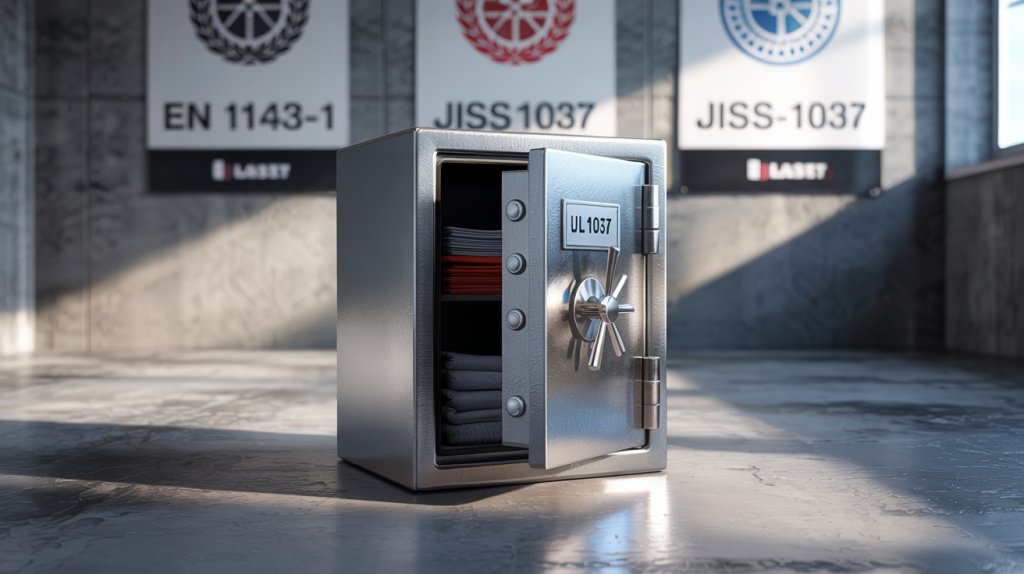
14. Can You Relocate the Safe?
Yes, but prepare for:
- Wall repairs: $200–$600 for drywall/plaster.
- Re-certification: $500+ for insurance compliance.
- Re-anchoring: Titanium bolts for concrete walls.
15. Integrating with Enterprise Security Systems
For Fortune 500-level protection:
- Sync with ID badges: Limit access to C-suite executives.
- AI monitoring: Flag unusual access patterns (e.g., 3 AM entries).
- Pressure sensors: Detect tampering during closed hours.
Conclusion
Wall-mounted jewelry safes are strategic assets for luxury businesses. By merging covert security with spatial efficiency, they protect high-value inventories while enhancing brand aesthetics. For jewelers, hotels, and elite estates, this isn’t just storage—it’s a competitive edge.
FAQ Section
Q1: What’s the minimum wall thickness required?
Concrete: 4 inches. Drywall: Requires steel backer plate.
Q2: Do mirrored safes show fingerprints?
Commercial models use anti-smudge nano-coatings.
Q3: Can I install in a bathroom?
Yes—choose 316L steel and silica gel dehumidifiers.
Q4: Are these safes earthquake-proof?
Models with inertial locks auto-lock during tremors.
Q5: How long do biometric sensors last?
10+ years with monthly alcohol wipe cleaning.


